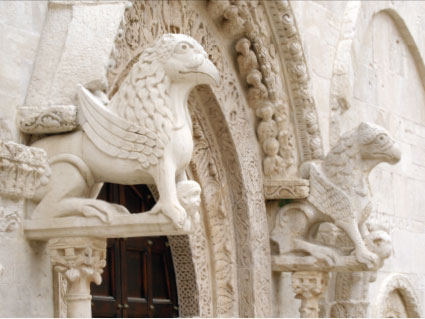




Founded after a people’s mission led by the Jesuit Domenico Bruno in 1719 as a congregation of people working in the fields, it was dedicated to the Purification of the Virgin and to St. Ignazio from Loyola. The historical events linked to the Jesuits’ expulsion from the Kingdom of Naples (1767) and to the suppression of the order determined a short inactivity of the confraternity. Later , in 1777, the confraternity was re-organized with new rules and was awarded by the Ferdinand IV’s royal acknowledgement.
In 1810 it moved to the Church of SS. Rosario, known as Church of S. Domenico, and it gave a fundamental contribution to the architectural and decorative restoration of the religious building. In 1883, by virtue of the Papal assent, the confraternity added to the Purification title, the Addolorata one.
Since its foundation, indeed, the confraternity, has been dedicating passionate devotional practices and ritual cults to Our Virgin of Sorrows, such as the Holy Friday Procession, before the Palm Sunday.
Corrado Binetti, a sculpture from Molfetta, , made the statue of the Virgin, called “desolata”, in 1907, following the popular devotional style: the Virgin, with a child-like face, is portrayed as wearing black clothes and embracing the Holy Cross. A golden dagger that symbolizes Simeone’s prophecy pierces the statues’s heart.
The same Cobfraternity organizes the procession of the Resurrected Christ in a joyful atmosphere on Easter Sunday when the old rite of the burso of the Quarantane is performed.
The first recorded account of the existence of a confraternity dedicated to the cult of the thaumaturge from Montpellier is the inscription engraved in the small church of St. Rocco in the main square of the town: until today people remind the perpetual indulgence granted by Pope Gregorio XIII in 1576 to “the chiìurch and confraternity of S. Rocco in Ruvo”. In the oldest archives, the confraternity is described as “poor” with reference to the social stauts of its members, most of them peasants.
In 1782 Ferdinand IV granted the access to the confraternity also to illiterate people: their signature was represented by the sign of the cross. The life confraternity is characterized by deep devotion and solidarity among its poorest members. The “Monte” of St. Rocco represents the charity actions provided also outside the confraternity.
Nowadays the confraternity takes care of the cult of Madonan del Buon Consiglio, whose celebration occurs in April with the procession of the statues of the Eight Saints during the night between the Holy Wednesday and Thursday.
The group is composed of life-height statues portraying Jesus Christ’s deposition. The group is carried by fifty brothers: the moving scene represents one the most touching scene of all the Easter rites in Ruvo.
It was founded in 1604 in the church of St. Vito thanks to virtuous priests and pious citizens and since then it is called Confraternita del Carmine.
Its members’ social statue is the core of the power that the confraternity has managed across centuries. They invested their money to widen and enrich the confraternity church and oratory, placed in a street called “Strignatora”, whre brothers used to meet together to pray or manage their business.
The confraternity was granted the royal acknowledgement in 1763.
They managed the so-called Monte Bares, founded thanks to the goods belonging to the notary Carlo Barese’s goods.
Since 17th century the confraternity has been organizing the procession of the Mysteries on Good Friday displaying many wooden statues representing Christ and the Virgin.
Deeply touching is the beautiful wooden statue portraying Jesus Christ carrying the Cross, made by Filippo Altieri in 1674: a long procession of barefoot worshippers follows the statue.
In the first half of the 17th century, a new nave was added in the old church of St. Cleto, first dedicated to St. Michen, then to Madonna del Suffragio, whose image painted by Plantamura from Naples, was collocated on the main altar.
The confraternity was founded in 1678 and in the same year it was aggregated to the confraternity of Suffragio in Rome to enjoy the the same privileges granted by the Pope.
Their main aim was the cult of the dead souls.
They administrated the Monte dei Morti, which in few year became one of the richest place of the town.
The incomes were used to devote masses and prayers for poor and sick people.
They also managed the Monte of Leone, founded by Francescantonio Leone in 1711.
The procession of Pieta statue dates back to the late 19th century, while the statue of the Virgin carrying her son dead on her legs was carved by Giuseppe Manzo, a sculptor from Lecce. The touching sculpture is carried, on Holy Saturday evening, by hundreds brothers wearing a white tunic cut with a black band portraying the Death symbol.